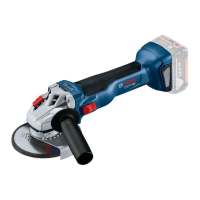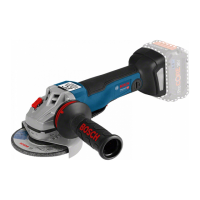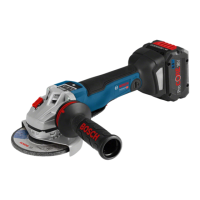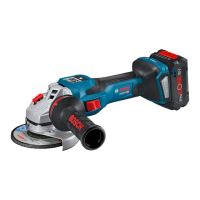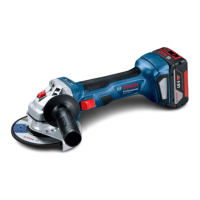English | 27
(9) is pressed unintentionally. As long as the battery is inser-
ted in the power tool, it is held in position by means of a
spring.
To remove the battery (8), press the release button (9) and
pull the battery out of the power tool. Do not use force to
do this.
Battery charge indicator
The green LEDs on the battery charge indicator indicate the
state of charge of the battery. For safety reasons, it is only
possible to check the state of charge when the power tool is
not in operation.
Press the button for the battery charge indicator or to
show the state of charge. This is also possible when the bat-
tery is removed.
If no LED lights up after pressing the button for the battery
charge indicator, then the battery is defective and must be
replaced.
Note: The state of charge of the battery is also displayed on
the user interface (5) (see "User interface (see figure B)",
page30).
Battery model GBA 18V...
LEDs Capacity
3× continuous green light 60−100%
2× continuous green light 30−60%
1× continuous green light 5−30%
1× flashing green light 0−5%
Battery model ProCORE18V...
LEDs Capacity
5× continuous green light 80−100%
4× continuous green light 60−80%
3× continuous green light 40−60%
2× continuous green light 20−40%
1× continuous green light 5−20%
1× flashing green light 0−5%
Fitting Protective Equipment
u Remove the battery from the power tool before carry-
ing out work on the power tool (e.g. maintenance,
changing tool, etc.). The battery should also be re-
moved for transport and storage. There is risk of injury
from unintentionally pressing the on/off switch.
Note: If the grinding disc breaks during operation or the
holding fixtures on the protective guard/power tool become
damaged, the power tool must be sent to the after-sales ser-
vice immediately; see the "After-Sales Service and Applica-
tion Service" section for addresses.
Protective guard for grinding
Place the protective guard
(12) onto the holder on the
power tool until the coding
cams of the protective guard
are aligned with the holder.
When doing so, press and
hold the unlocking lever (1).
Press the protective guard
(12) onto the spindle collar
until the shoulder of the pro-
tective guard is sitting on the
flange of the power tool and
rotate the protective guard
until it audibly clicks into
place.
Adjust the position of the protective guard (12) to meet the
requirements of the operation. To do this, push the unlock-
ing lever (1) upward and rotate the protective guard (12)
into the required position.
u Always position the protective guard(12) such that
the two cams on the unlocking lever(1) engage in the
corresponding openings on the protective guard(12).
u Adjust the protective guard (12) such that sparking in
the direction of the operator is prevented.
u The protective guard (12) must only be adjustable
while the unlocking lever (1) is actuated. Otherwise,
the power tool must not be used any more under any
circumstances and must be sent to the after-sales ser-
vice.
Note: The coding cams on the protective guard (12) ensure
that only a protective guard that is suitable for the power
tool can be fitted.
Protective guard for cutting
u Always use the protective guard for cutting (17) when
cutting bonded abrasives.
u Provide sufficient dust extraction when cutting stone.
The protective guard for cutting (17) is fitted in the same
way as the protective guard for grinding (12).
Extraction guard for sanding
The extraction guard (11) can be used to minimise dust
when sanding paint, varnish and plastics in conjunction with
the carbide grinding head (16). The extraction guard (11) is
not suitable for working metals.
A suitable Bosch vacuum cleaner can be connected to the
extraction guard (11).
The extraction guard (11) is mounted in the same manner as
the protective guard (12). The brush collar can be replaced.
Extraction guard for cutting with a guide block
The extraction guard for cutting with a guide block (27) is fit-
ted in the same way as the protective guard for grinding
(12).
Bosch Power Tools 1 609 92A 5FJ | (06.10.2020)
